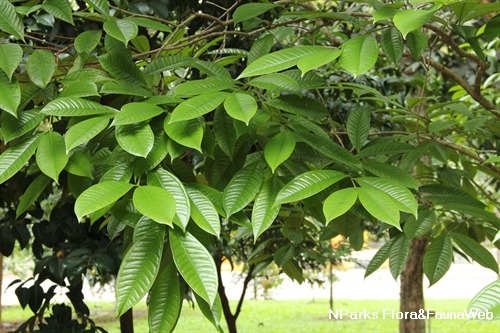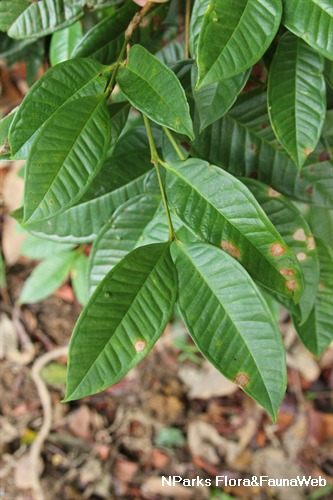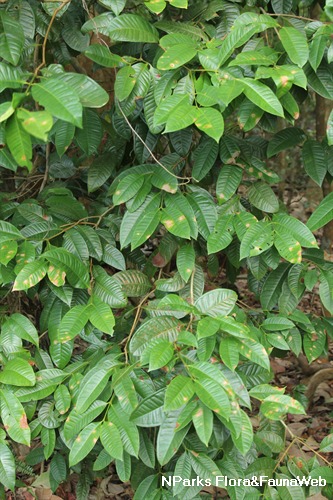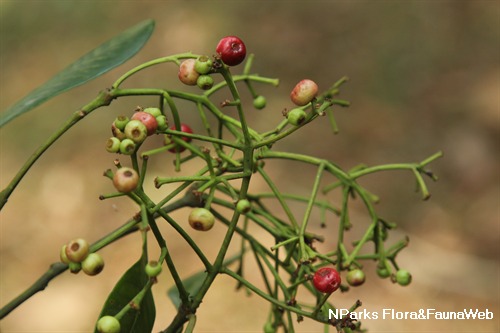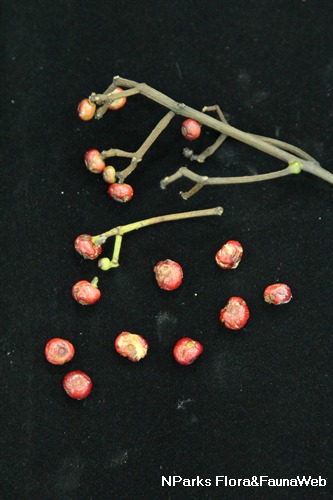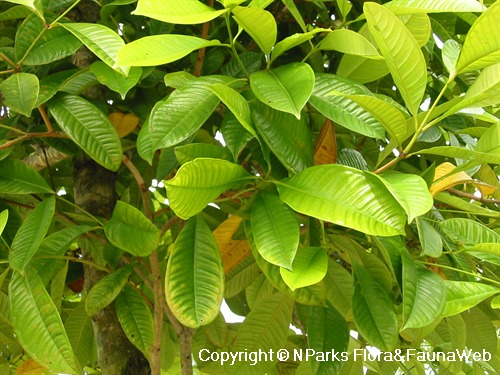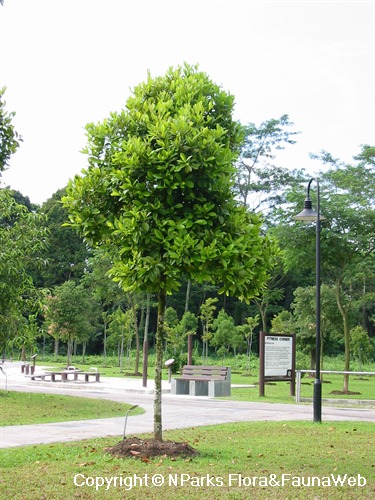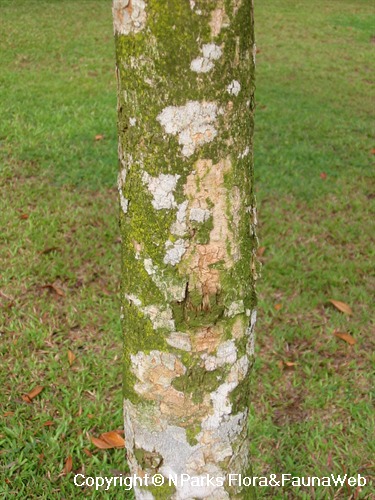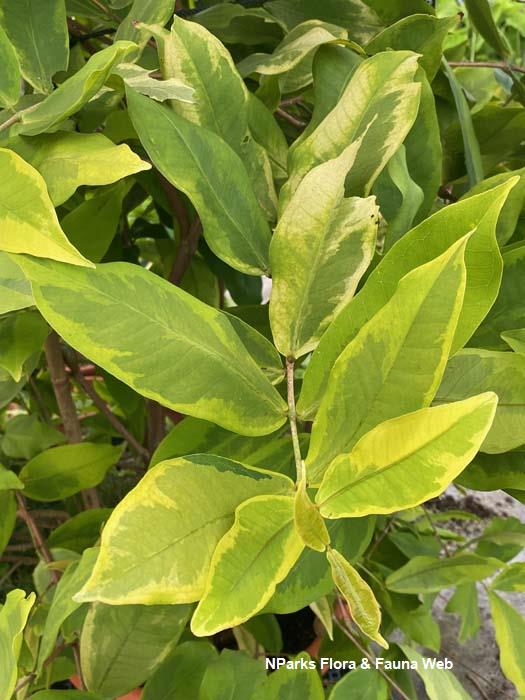
Back
Syzygium borneense (Miq.) Miq.
| Family Name: | Myrtaceae |
| Synonyms: | Eugenia pseudosubtilis, Eugenia irregularis, Eugenia borneensis, Eugenia litseifolia, Eugenia microcalyx var. obovata, Syzygium glaucescens, Syzygium myrtillus var. borneense, Syzygium litseifolium, Syzygium irregulare |
| Common Name: | Bullate Eugenia |
Name
Classifications and Characteristics
| Plant Division | Angiosperms (Flowering Seed Plants) (Dicotyledon) |
|---|---|
| Plant Growth Form | Tree (Medium (16m-30m)) |
| Lifespan (in Singapore) | Perennial |
| Mode of Nutrition | Autotrophic |
| Plant Shape | Oval |
| Maximum Height | 16 m to 20 m |
Biogeography
| Native Distribution | From Vietnam, through Peninsular Malaysia, Singapore to Borneo |
|---|---|
| Native Habitat | Terrestrial (Primary Rainforest, Monsoon Forest, Secondary Rainforest, Freshwater Swamp Forest) |
| Preferred Climate Zone | Tropical, Sub-Tropical / Monsoonal |
| Local Conservation Status | Native to Singapore (Least Concern (LC)) |
Description and Ethnobotany
| Growth Form | It is a tree that can grow up to 20 m tall and attain 120 cm in trunk girth size. |
|---|---|
| Foliage | Its opposite, stalked leaves have leaf blades that are leathery, dark shiny green above, paler green below, lance-shaped or oval or egg-shaped, and 5–20 cm by 2–9.5 cm. Each leaf blade has 1 vein running parallel to the blade margin, 8–14 pairs of side veins with bulging upwards of the blade in between, and a short pointed or blunt leaf tip. |
| Flowers | It produces bisexual flowers that are small, yellowish-white, about 4 mm across, and are found in up to 5–16 cm long flower clusters located at the axils of its leaves or ends of its branches. |
| Fruit | It produces fleshy fruits that are round, white tinged red or pink, about 0.4–0.8 cm across, and have 1 somewhat-round seed each. |
| Habitat | It usually grows in primary and secondary lowland forests and freshwater swamp forests. |
| Associated Fauna | Its flowers are probably pollinated by bats, and its fruits are probably eaten by birds. |
| Cultivation | It can be propagated by seed. |
| Etymology | Greek syzygos, joined, referring to the paired leaves of this species; Latin borneense, of Borneo, referring to one locality in the natural distribution of the species |
| Ethnobotanical Uses | Edible Plant Parts : Edible Fruits |
Landscaping Features
| Landscaping | It is suitable for parks and roadside planting. |
|---|---|
| Desirable Plant Features | Ornamental Foliage |
| Landscape Uses | General, Suitable for Roadsides, Parks & Gardens |
| Thematic Landscaping | Naturalistic Garden |
Fauna, Pollination and Dispersal
| Fauna Pollination Dispersal Associated Fauna | Bird-Attracting (Fruits) |
|---|---|
| Pollination Method(s) | Biotic (Fauna) |
| Seed or Spore Dispersal | Biotic (Fauna) |
Plant Care and Propagation
| Light Preference | Full Sun |
|---|---|
| Water Preference | Moderate Water |
| Plant Growth Rate | Moderate |
| Rootzone Tolerance | Fertile Loamy Soils, Well-Drained Soils, Moist Soils |
| Maintenance Requirements | Moderate |
| Propagation Method | Seed |
Foliar
| Foliage Retention | Evergreen |
|---|---|
| Mature Foliage Colour(s) | Green |
| Mature Foliage Texture(s) | Smooth, Glossy / Shiny, Raised / Sunken Veins |
| Foliar Type | Simple / Unifoliate |
| Foliar Arrangement Along Stem | Opposite |
| Foliar Attachment to Stem | Petiolate |
| Foliar Shape(s) | Non-Palm Foliage (Oval, Lanceolate, Elliptical) |
| Foliar Venation | Pinnate / Net |
| Foliar Margin | Entire |
| Leaf Area Index (LAI) for Green Plot Ratio | 3.0 (Tree - Intermediate Canopy) |
Non - Foliar and Storage
| Trunk Type (Non Palm) | Woody |
|---|---|
| Stem Type & Modification | Woody |
| Root Type | Underground (Tap Root, Fibrous Root) |
Floral (Angiosperm)
| Flower & Plant Sexuality | Bisexual Flowers |
| Flower Colour(s) | Cream / Off-White |
|---|---|
| Flower Grouping | Cluster / Inflorescence |
| Flower Location | Axillary |
| Flower Symmetry | Radial |
| Ovary Position | Inferior / Epipgynous |
| Flowering Habit | Polycarpic |
Fruit, Seed and Spore
| Mature Fruit Colour(s) | Red, White |
|---|---|
| Fruit Classification | Simple Fruit |
| Fruit Type | Fleshy Fruit , Berry |
Image Repository
Others
| Master ID | 1862 |
|---|---|
| Species ID | 3155 |
| Flora Disclaimer | The information in this website has been compiled from reliable sources, such as reference works on medicinal plants. It is not a substitute for medical advice or treatment and NParks does not purport to provide any medical advice. Readers should always consult his/her physician before using or consuming a plant for medicinal purposes. |


